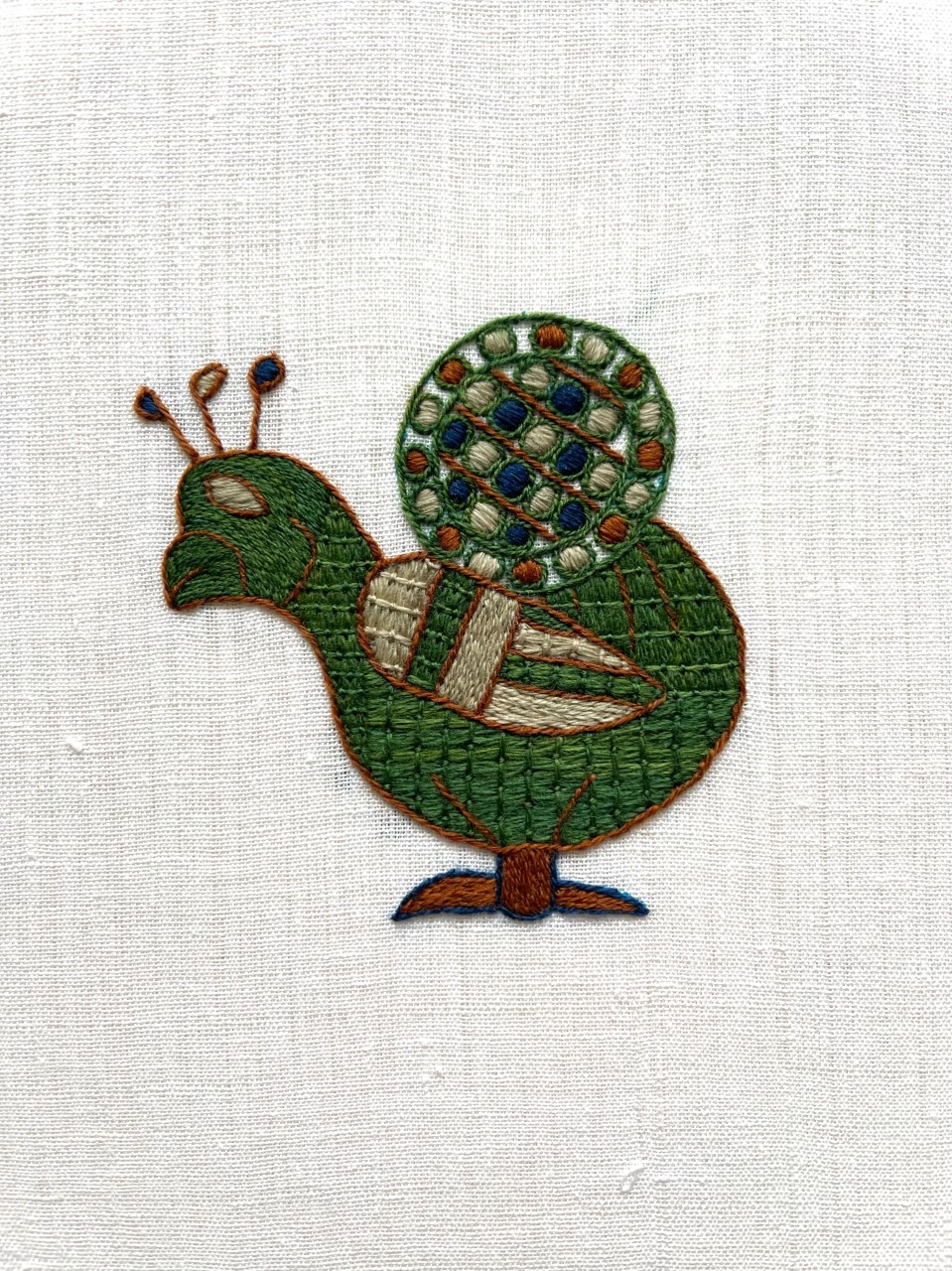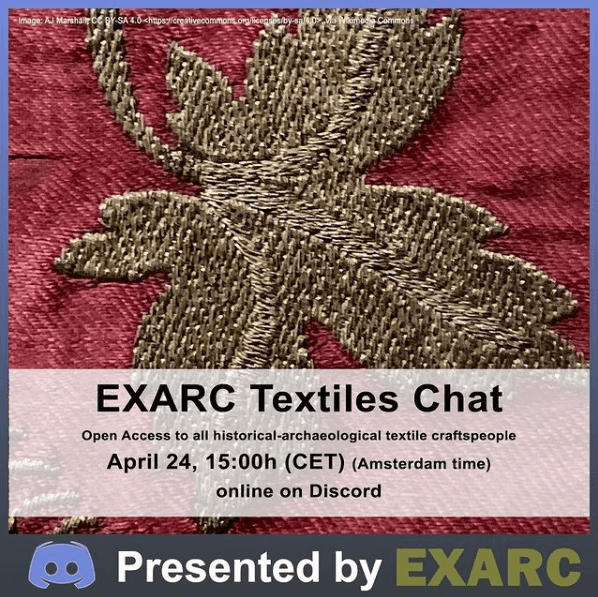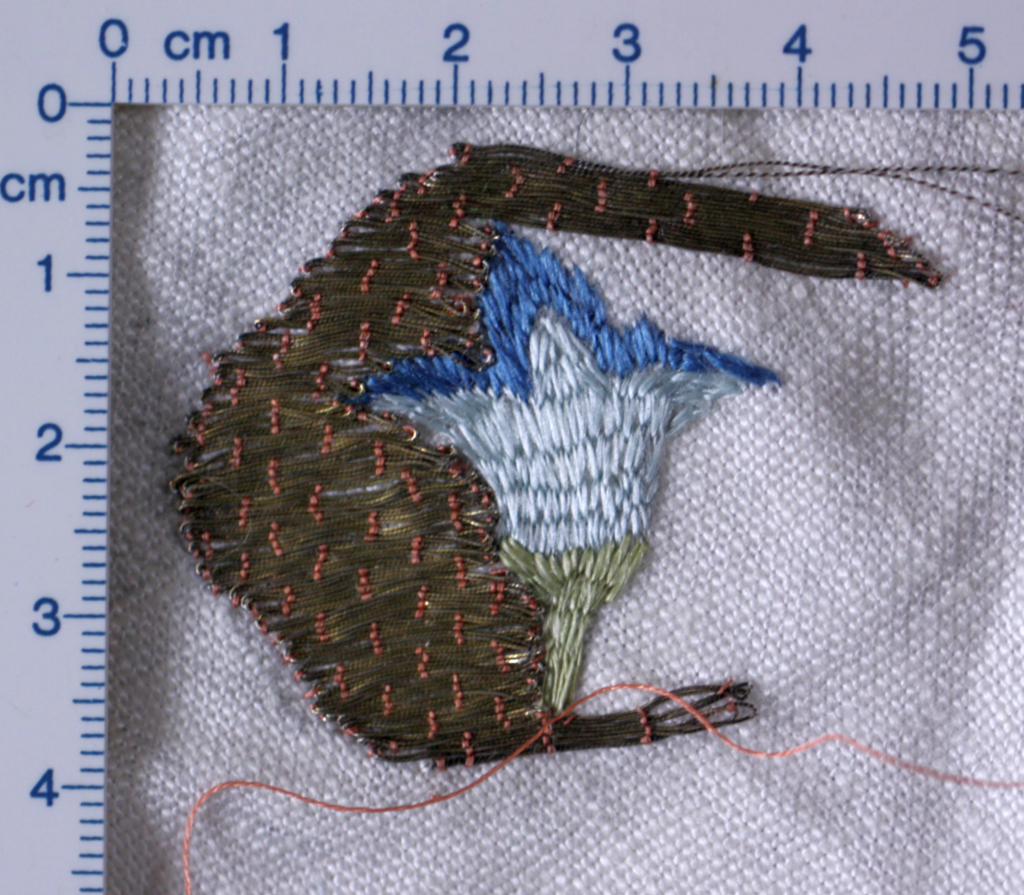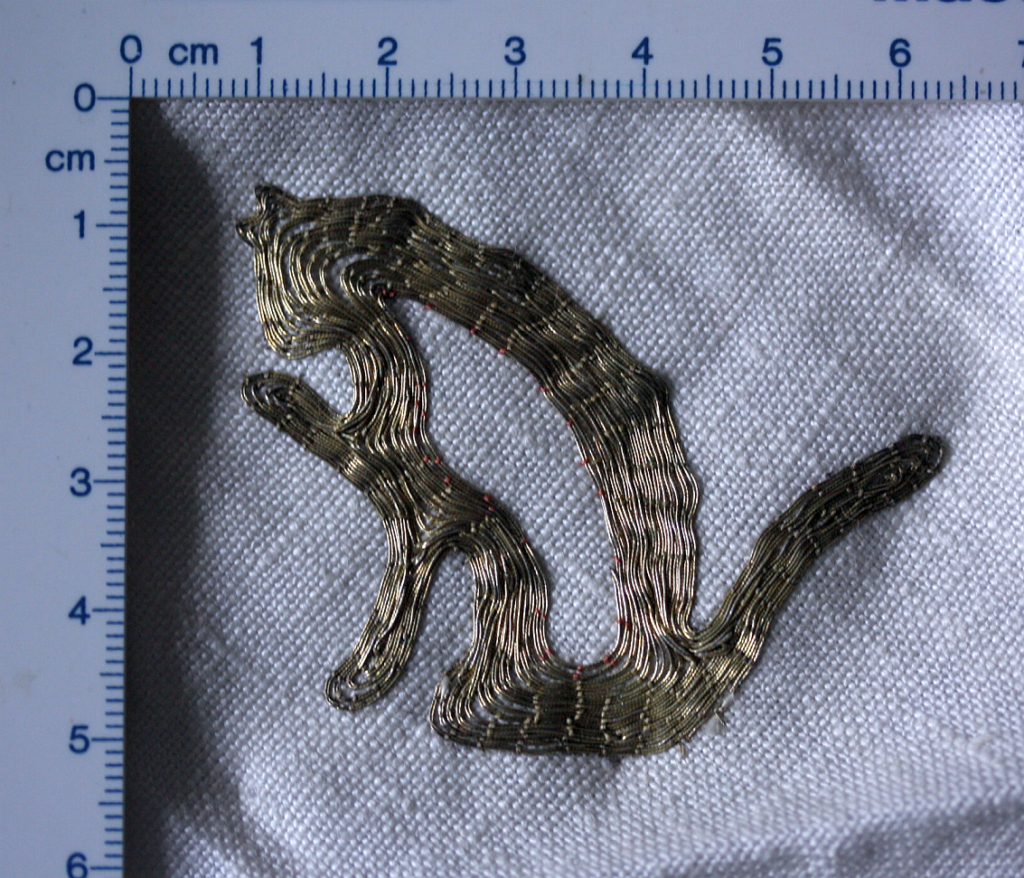In case you're looking for something special, embroidery-wise:
My colleague Dr. Alex Makin has put together kits for Bayeux-style stitching!
Now... Alex is a textile archaeologist specialising in early medieval embroidery and a professionally trained embroiderer. Add those together, and the result is that her kits are not just any random bits of fabric and thread... obviously.
The Bayeux kit contains hand-woven fabric to the specifications of the original ground weave of the tapestry. The embroidery threads are wool, and of course they are hand-dyed in natural colours, similar to the colours used in the original. You also get a handmade bronze needle for the stitching, and a booklet with instructions so you can stitch your peacock... because that is the motif for this kit.

Which means that if you'd like to get a taste on how the original Bayeux tapestry was done, and how it felt to stitch it, this is the kit to get. You can learn more about the kits, and pre-order them, here on Alex' site.
Search the Blog
Latest Comments
Harma
Blog Break .
29. April 2024
Isn't the selvedge something to worry about in a later stage? It seems to me a lot more important th...
Beatrix
Experiment!
23. April 2024
The video doesn´t work (at least for me). If I click on "activate" or the play-button it just disapp...
Katrin
Spinning Speed Ponderings, Part I.
15. April 2024
As far as I know, some fabrics do get washed before they are sold, and some might not be. But I can'...
Kareina
Spinning Speed Ponderings, Part I.
15. April 2024
I have seen you say few times that "no textile ever is finished before it's been wet and dried again...
Katrin
How on earth did they do it?
27. März 2024
Ah, that's good to know! I might have a look around just out of curiosity.
I've since learned that w...
DEZ.
10
0
JULI
07
If you've done research about early medieval embroidery, you've probably come across the Maaseik embroideries - silk and goldwork, preserved in Maaseik, and there's pictures of them online at kikirpa.be.
Brand new, though, is this: Alexandra Makin has made a presentation about these pieces, and the results of an examination that she did. Watch it right here:
Brand new, though, is this: Alexandra Makin has made a presentation about these pieces, and the results of an examination that she did. Watch it right here:
Datenschutzhinweis
Diese Webseite verwendet YouTube Videos. Um hier das Video zu sehen, stimmen Sie bitte zu, dass diese vom YouTube-Server geladen wird. Ggf. werden hierbei auch personenbezogene Daten an YouTube übermittelt. Weitere Informationen finden sie HIER
APR.
22
The Early Textiles Study Group has opened their Call for Papers for the next conference, which is planned for Manchester on September 9-11. In case in-person is not possible, it will be held virtually.
The title is ‘Legacy: textile studies, the past informing the present’. The ETSG is thus looking for papers that explore any aspect of the legacies of the study of early textiles. Topics may include, but are not limited to:

Definitely virtually, and taking place this Saturday, is the next EXARC textile chat. As usual, you can find it on their Discord server, and it will start at 15:00 CET. This month, the topic is embroidery.
The title is ‘Legacy: textile studies, the past informing the present’. The ETSG is thus looking for papers that explore any aspect of the legacies of the study of early textiles. Topics may include, but are not limited to:
- Pioneers in the study and reconstruction of early textiles,
- Collections, their histories and their futures,
- Fresh insights gained by applying new methodologies to old collections and archives.

Definitely virtually, and taking place this Saturday, is the next EXARC textile chat. As usual, you can find it on their Discord server, and it will start at 15:00 CET. This month, the topic is embroidery.
APR.
21
In case you're looking for something to watch, Alexandra Makin of the Cuthbert Project (yes, that one with the lovely embroidery silk threads that I was involved in) has started a YouTube channel, and she's already put three videos into it - two of which are about the Cuthbert maniple.
You can find her channel here. Enjoy!
You can find her channel here. Enjoy!
FEB.
23
You probably know that - you're looking at some newsfeed or something on the internet, and suddenly something really cool and exciting pops up. That is just what happened to me, leading to my finding out about the Bayeux Tapestry online.
In a project to make the embroidery more accessible and digitally available, the whole 70 metres have been photographed and then pieced together into a large panorama - which is now freely accessible online. So you can have a look at whatever piece you want to, and even zoom in quite a bit. Here's the museum's info and intro page to the Online Tapestry.
I've spent some time already squinting at the stitches in different parts. Of course, I immediately had an Oliver Twist moment when clicking on the zoom-in button, when I would really have liked to have just one more... but didn't get it. Still, it's wonderful, and probably allows a closer look than going to visit the original piece!
In a project to make the embroidery more accessible and digitally available, the whole 70 metres have been photographed and then pieced together into a large panorama - which is now freely accessible online. So you can have a look at whatever piece you want to, and even zoom in quite a bit. Here's the museum's info and intro page to the Online Tapestry.
I've spent some time already squinting at the stitches in different parts. Of course, I immediately had an Oliver Twist moment when clicking on the zoom-in button, when I would really have liked to have just one more... but didn't get it. Still, it's wonderful, and probably allows a closer look than going to visit the original piece!
FEB.
03
Here's another picture of embroidery featuring gold - this is the sample (unfinished, of course) where I did the counting of how many threads were lying side to side:

The silk parts are worked in split stitch, the gold is couched down with a red silk thread in the same thickness. As you can see, I was not very good at this kind of stitching when I made the sample - which was quite a few years ago! I did this bit mostly to show how the silk and gold would look together, and how split stitch can be used to cover an area. So it was stitched on a rough charcoal drawing as a template, and the gold patch also only outlined with coal, still faintly visible and not very rounded or symmetrical.
Like most of my sample bits, this has been dragged around and stuffed into baskets and boxes and taken out and fingered and then stuffed back in wherever it came from. I've also cleaned (gently washed) all my samples at least once by now. The gold has developed a little bit of a patina due to all this, but it's still pretty and shiny when light falls on it. So - it does hold up quite well!

The silk parts are worked in split stitch, the gold is couched down with a red silk thread in the same thickness. As you can see, I was not very good at this kind of stitching when I made the sample - which was quite a few years ago! I did this bit mostly to show how the silk and gold would look together, and how split stitch can be used to cover an area. So it was stitched on a rough charcoal drawing as a template, and the gold patch also only outlined with coal, still faintly visible and not very rounded or symmetrical.
Like most of my sample bits, this has been dragged around and stuffed into baskets and boxes and taken out and fingered and then stuffed back in wherever it came from. I've also cleaned (gently washed) all my samples at least once by now. The gold has developed a little bit of a patina due to all this, but it's still pretty and shiny when light falls on it. So - it does hold up quite well!
FEB.
02
I've been asked recently about how much gold thread to calculate for covering a given area - so I've taken out my samples and took a look, and did some maths, and maybe that's interesting for you, too.
The gold thread that I have in the shop is about 0,2 mm in diameter - so if we assume that it will be couched down perfectly, one thread right beside the next, and there's no significant gap between threads, 50 threads next to each other are needed to cover a width of one centimeter. For a stripe one centimeter wide and ten centimeters long, accordingly 5 metres of thread are needed - plus a little more, since it's necessary to have a little bit of thread to pull to the back of the fabric.
When I had my gold embroidery starter kit fairly new, I found a volunteer to test it for me, and these are the results of stitching with 5 m of gold thread:
[caption id="attachment_5805" align="alignnone" width="640"] This is how much ground you can cover with 5 m of gold thread.
This is how much ground you can cover with 5 m of gold thread.
That's roughly in the area of the 10 x 1 cm stripe. As you can see in the picture (hopefully - it's really hard to take a good photo of gold embroideries!) there are areas where the threads overlap a little, and areas where there are narrow gaps, and that can even itself out or, if you tend more towards one or the other, it will reduce or extend your covered area slightly.
As to the number of threads lying beside each other, I did some counting on a piece where I had threads couched all in parallel, and I got about 21 to 23 threads on 5 mm - so about 42 to 46 per centimeter. Which is close to the theoretical 50, but not quite there, just like I would have expected.
For calculating thread needs, thus, 50 cm of thread per square centimeter seems to be a good ballpark number - it should give you enough wiggle room to anchor your thread ends and safely cover that area, even if you have a little bit of overlap here or there.
The gold thread that I have in the shop is about 0,2 mm in diameter - so if we assume that it will be couched down perfectly, one thread right beside the next, and there's no significant gap between threads, 50 threads next to each other are needed to cover a width of one centimeter. For a stripe one centimeter wide and ten centimeters long, accordingly 5 metres of thread are needed - plus a little more, since it's necessary to have a little bit of thread to pull to the back of the fabric.
When I had my gold embroidery starter kit fairly new, I found a volunteer to test it for me, and these are the results of stitching with 5 m of gold thread:
[caption id="attachment_5805" align="alignnone" width="640"]
 This is how much ground you can cover with 5 m of gold thread.
This is how much ground you can cover with 5 m of gold thread.That's roughly in the area of the 10 x 1 cm stripe. As you can see in the picture (hopefully - it's really hard to take a good photo of gold embroideries!) there are areas where the threads overlap a little, and areas where there are narrow gaps, and that can even itself out or, if you tend more towards one or the other, it will reduce or extend your covered area slightly.
As to the number of threads lying beside each other, I did some counting on a piece where I had threads couched all in parallel, and I got about 21 to 23 threads on 5 mm - so about 42 to 46 per centimeter. Which is close to the theoretical 50, but not quite there, just like I would have expected.
For calculating thread needs, thus, 50 cm of thread per square centimeter seems to be a good ballpark number - it should give you enough wiggle room to anchor your thread ends and safely cover that area, even if you have a little bit of overlap here or there.



